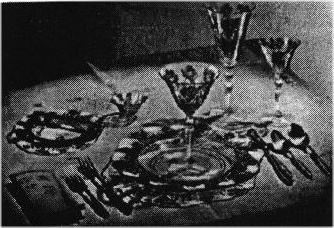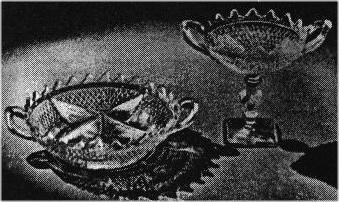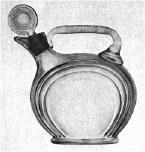How Green It Was - Part II
by Mark A. Nye
Issue No. 243 - July 1993
The first trade journal reference to Forest Green that I found is in the August 1931 issue of Crockery and Glass Journal. In his column "Chicago & the Mid~West, John M Smythe included the following paragraphs:
Cambridge Line Presents Many New Fall Items
"Cambridge Glass Co. is showing a number of very attractive new offerings for fall in its permanent showroom, Room 1347, Merchandise Mart, Chicago. Among the most unusual of these items is a new color by Cambridge called Forest Green. This color is available in a wide variety of pieces.
"A new stemware line is most unique. The stem consists of a beautifully executed crystal figure and the bowls may be had a a choice of colors, amethyst, royal blue, gold krystol and Forest Green.
There were several additional paragraphs dealing with the Fall offerings by Cambridge; none contained further references to Forest Green.
The caption to a photograph published in the September 1931 issue of
 China, Glass and Lamps, contains the first reference to Forest
Green found in that journal:
China, Glass and Lamps, contains the first reference to Forest
Green found in that journal:
"(at right) is some Cambridge glass dinnerware, their No. 3400 line, combined with which is the No. 3035 steniware shape. Both feature the Gloria pattern. While crystal is shown in the illustration, this may be had in the full range of Cambridge colors, outstanding among which is their brand new Forest Green. This is being shown at their display room, 184 Fifth avenue." [New York City, NY]
Gloria on Forest Green blanks is seldom seen today and assembling any type of set of either stemware or flatware would be quite a challenge.
That Forest Green was introduced during 1931 is further confirmed by
the fact that it was not listed in the 1931 Glass Factory
 Directory Cambridge advertisement. It was in the 1932 edition:
Directory Cambridge advertisement. It was in the 1932 edition:
"The Mount Vernon pattern ... by the Cambridge Glass Co. ... is a brilliant crystal, it naturally lends itself to the early American dining room ensemble. The Mount Vernon is made in the finest Cambridge antique colors of amber, royal blue, forest green, carmen and crystal." CGL. February 1932
"MARTHA WASHINGTON GLASSWARE
"In Cambridge reproductions of authentic Early American patterns. A full and complete line obtainable in sparkling crystal, the antique colors of amber, royal blue, forest green and ruby and in the modern colorings, Heatherbloom and Gold Krystol."
Cambridge advertisement - June 1932 issue CGL.
While this is an article on Cambridge greens, let me diverge long enough to say that there is absolutely no indication that the color ruby referred to in the preceding is anything but what we know as Carmen. Why it was called ruby in this advertisement is a question that will probably remain unanswered.
An October 1932 advertisement in CGL, featured the No. 3400/113 35 ounce handled decanter and No. 1341 1 ounce cordial and the text read:
" ... a new handled decanter set from the Cambridge Glass Co. It
is one of their new smart Fall items and is shown in amber, forest green, carmine, amethyst, royal blue as well as crystal, In addition to these plain colors it is also to be had in etchings.
A year later, and again in CGL, this caption was used along with a picture of Cambridge glass:
"One of the new lines to be brought out this Fall by the Cambridge Glass Co. is their Everglades. [shown at right] The few pieces of this which we illustrate will give an idea of its attractiveness. In addition to the items pictured, this line also consists of three or four types of candlesticks, high, low and double candelabra, various bowls of different types and shapes and four different types of vases. It is to be had in colors of crystal, Eleanor blue, Forest green, and amber with a few pieces made in Carmen (ruby)."
October 1934 saw a full page Cambridge advertisement published in
CGL. Shown in the advertisement were the narcissus bulb vase, a
floating rose bowl, and the Nautilus handled decanter and wine glass,
 The text for the Nautilus illustration read:
The text for the Nautilus illustration read:
"The Nautilus design is an outstanding creation. Wine sets are especially attractive because of the striking decanter [right] and the handsome glasses, Done in Crystal, Amber, Royal Blue, Forest Green, Amethyst and Carmen and combinations of crystal and color. Protected by Design Patents 84482 and 89828."
The Sea Shell line was being promoted as new during early 1935. The following is from the February 1935 issue of CGL.
" 'Sea~Shell' is a new Cambridge Glass Co. creation ... marine motifs with the shell predominating ... produced in new, translucent coral color and also in carmen, amber, royal blue, forest green, and amethyst."
After 1935, Forest Green was seldom mentioned in the trade journals. While color remained very much a part of the Cambridge line, the popularity of colored dinnerware, stemware and accessory items was beginning to decline. Forest Green was a production color when the 1940 Cambridge catalog was issued January 1, 1940. It was the fall of 1943 when wartime shortages caused Cambridge to discontinue production of many colors, including Forest Green.
With the arrival of the 1940s, Mount Vernon. Martha Washington and Everglades lines were no longer available in Forest Green - Portions of the Tally Ho 3400 and Gadroon lines continued to be offered in Forest Green and other colors as well. Stemware lines available with Forest Green bowls included numbers 1066. 3035, 3011, 3077, 3126 and 3103.
What is Forest Green? Describing a color is difficult at best. In the book Colors In Cambridge Glass, Forest Green is described in this manner:
"It [Forest Green] is a soft, cool, dark shade of transparent green that tends toward yellow."
As with most colors, when used for thin blown items, the color appears to be lighter. Conversely, pressed items in Forest Green appear to he darker than blown items. For an illustration of Forest Green, as well as all the other Cambridge colors, the reader is referred to Colors In Cambridge Glass.
Forest Green can be confused with the green Cambridge brought out in 1949. Known then simply as Emerald, today it is commonly called late Emerald or late dark Emerald to avoid confusion with earlier colors that used the same name. However, in most, if not all instances, if there is a question, the piece will identify the color. This is because there appear to be no items that were made in both colors. This will be further discussed in a future article covering late Emerald.
The Cambridge green color known as Pistachio was introduced in the Spring of 1938. It will not he confused with any other Cambridge green except perhaps for the reopened period color also known as Pistachio. Once a collector has seen both colors, however, there will be little or no problem distinguishing between the two. In addition, very little of the reopened period Pistachio is found and the pieces themselves will identify the color as the late Pistachio. Late Pistachio will be covered in the concluding article to this series.
The original Pistachio was used for items from the Caprice and Gyro Optic lines. It was also used for a few small Items from the Martha line, primarily the individual cream and sugar. In addition, you will find several miscellaneous items in this color. These include the Regency cocktail and cordial, the Bridge Hound and the No. 1506 novelty baskets.
Pistachio remained in the Cambridge line until 1943 but was seldom mentioned in trade journals or Cambridge advertising.
To be continued ...
